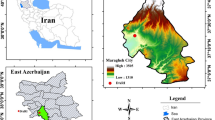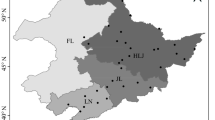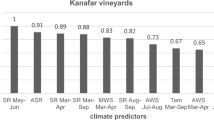Abstract
Knowledge of variability in phenological traits is of utmost importance in breeding new almond cultivars in the context of impending climate change. The Northwestern Himalayan region is characterized by extreme winters, and phenological studies of fruit crops in relation to environmental variables in this region are scant. Flowering time being an important trait governing agricultural productivity, the objectives of this study were the evaluation of local and exotic almond cultivars for blooming initiation and other associated parameters. This study also aimed at deciphering the association between bloom dates in almonds and prevailing temperatures. Field phenological observations were performed during seven growing seasons (2012–2018) in Kashmir. Phenological traits like endodormancy breaking were estimated using the correlation model. The heat requirements for blooming were estimated using the growing degree days (GDD) method. The association between average temperatures and days to flowering was studied using partial least squares (PLS) regression. Local cultivars ‘Makhdoom’ and ‘Shalimar’ were earliest to bloom within 80 days, while the exotic cultivars were late bloomers, requiring 87 days. Cultivars ‘Makhdoom’, ‘Shalimar’, ‘Drake’ and ‘Pranyaj’ broke their endodormancy on the same date, i.e. December 26, although another group including ‘Waris’, ‘California Paper Shell’ and ‘Merced’ exhibited endo- to ecodormancy transition on January 21. In general, Himalayan-origin almond cultivars revealed low heat requirements for flowering compared to the exotic ones. PLS regression analysis identified four major periods in which average temperatures successfully explained variation in days to blooming in almonds. In conclusion, a phenological prediction model is presented here that explains variation in blooming dates in almond cultivars as a function of average temperatures. This model addresses the almond cultivars growing in the Himalayan region and is expected to be of great practical utility to the farming community to efficiently plan their orchard management practices.



Similar content being viewed by others
References
Ahmed N, Lone FA, Hussain K, Kanth RH, Sheraz MS (2019) Impact of climate change on temperate fruit production in kashmir valley, north western himalayan region of India—challenges, opportunities and way forward. In: Sheraz Mahdi S (ed) Climate change and agriculture in India: impact and adaptation. Springer, Cham https://doi.org/10.1007/978-3-319-90086-5_20
Alonso JM, Ansón JM, Espiau MT, Socias I Company R (2005a) Determination of endodormancy break in almond flower buds by a correlation model using the average temperature of different day intervals and its application to the estimation of chill and heat requirements. J Amer Soc Hort Sci 130:308–318
Alonso JM, Espiau MT, Ansón JM, Socias I Company R (2005b) Development of a method to estimate flower bud dormancy breaking in almond. Options Méditerr Sér A 63:171–177
Alonso JM, Ansón JM, Espiau MT, Socias I Company R (2011) Stability of the almond blooming date in a Changing Climate. Acta Hortic 912:337–342
Díez-Palet I, Funes I, Savé R, Biel C, de Herralde F, Miarnau X, Vargas F, Àvila G, Carbó J, Aranda X (2019) Blooming under Mediterranean climate: Estimating cultivar-specific chill and heat requirements of Almond and Apple trees using a statistical approach. Agronomy 9:760. https://doi.org/10.3390/agronomy9110760
Dirlewanger E, Quero-Garcı’a J, Le Dantec L, Lambert P, Ruiz D, Dondini L, Illa E, Quilot-Turion B, Audergon JM, Tartarini S, Letourmy P, Aru’s P (2012) Comparison of the genetic determinism of two key phenological traits, flowering and maturity dates, in three Prunus species: peach, apricot, and sweet cherry. Heredity 109:280–292
Dose V, Menzel A (2006) Bayesian correlation between temperature and blossom onset data. Glob Chang Biol 12:1451–1459
El Yaacoubi A, Oukabli A, Legave JM, Ainane T, Mouhajir A, Zouhair R, Hafidi M (2019) Response of almond flowering and dormancy to Mediterranean temperature conditions in the context of adaptation to climate variations. Sci Hortic 257:108687
Fadón E, Herrera S, Guerrero BI, Guerra ME, Rodrigo J (2020) Chilling and heat requirements of temperate stone fruit trees (Prunus sp.). Agronomy 10:409. https://doi.org/10.3390/agronomy10030409
Freitas TR, Santos JA, Silva AP et al (2023) Evaluation of historical and future thermal conditions for almond trees in north-eastern Portugal. Clim Change 176:89. https://doi.org/10.1007/s10584-023-03569-2
Gradziel TM, Martínez-Gómez P (2013) Almond breeding. In: Janick J (ed) Plant breeding reviews https://doi.org/10.1002/9781118497869.ch4
Guillamón JG, Egea J, Mañas F et al (2022) Risk of extreme early frosts in almond. Horticulturae 8:687. https://doi.org/10.3390/horticulturae8080687
Kester DE, Gradziel TM (1996) Almonds. In: Janick J, Moore JN (eds) Fruit breeding. Wiley, New York, pp 1–97
Kumar D, Ahmed N (2014) Response of Nitrogen and Potassium Fertigation to “Waris” Almond (Prunus dulcis) under Northwestern Himalayan Region of India. Sci World J. https://doi.org/10.1155/2014/141328
Lloret A, Badenes ML, Ríos G (2018) Modulation of dormancy and growth responses in reproductive buds of temperate trees. Front Plant Sci 9:1368. https://doi.org/10.3389/fpls.2018.01368
Lorite IJ, Cabezas-Luque JM, Arquero O et al (2020) The role of phenology in the climate change impacts and adaptation strategies for tree crops: a case study on almond orchards in Southern Europe. Agric Forest Meteorol 294:108142. https://doi.org/10.1016/j.agrformet.2020.108142
Majid S, Kumar A, Naseer S, Bashir S, Mughal MN, Dar ZA, Amin A, Rashid Z, Rasool F, Haqeem S (2021) Floral biology of exotic and indigenous almond (Prunus amygdalus Batsch.) genotypes under temperate conditions of Kashmir valley. Int J Curr Microbiol App Sci 10:2807–2813. https://doi.org/10.20546/ijcmas.2021.1001.325
Miranda C, Santesteban G, Royo B, de Pamplona U (2005) Variability in the relationship between frost temperature and injury level for some cultivated Prunus species. Hort Sci 40:357–361
Sakar EH, El Yamani M, Boussakouran A, Rharrabti Y (2019) Codification and description of almond (Prunus dulcis) vegetative and reproductive phenology according to the extended BBCH scale. Sci Hortic 247:224–234
Sakar EH, El Yamani M, Boussakouran A, Rharrabti Y (2023) Reproductive phenology calendar and its correlation with air temperature in five Mediterranean almond [Prunus dulcis (Mill.) D.A. Webb] cultivars grown in Morocco. Sci Hortic 316:112014
Sánchez-Pérez R, Dicenta F, Martínez-Gómez P (2012) Inheritance of chilling and heat requirements for flowering in almond and QTL analysis. Tree Genet Genom 8:379–389
Shabir W (2017) Almond production on decline as growers blame Kashmir weather. The Indian Express: July 10.
Silva C, Garcia-Mas J, Sanchez AM, Aru’s P, Oliveira MM (2005) Looking into flowering time in almond (Prunus dulcis (Mill) D. A. Webb): the candidate gene approach. Theor Appl Genet 110:959–968
Soodan AS, Koul AK, Wafai BA (1989) Floral biology of almond (Prunus amygdalus L. Batsch) under cultivation in Kashmir valley. Proc Indian Acad Sci 99:297–300
Sperling O, Kamai T, Tixier A, Davidson A, Jarvis-Shean K, Raveh E, DeJong TM, Zwieniecki MA (2019) Predicting bloom dates by temperature mediated kinetics of carbohydrate metabolism in deciduous trees. Agric For Meteorol 276–277:107643. https://doi.org/10.1016/j.agrformet.2019.107643
Tabuenca MC (1972) Necesidades de frio invernal en almendro. Anales Aula Dei 11:325–329
Thomas D (2019) Managing Almond Production in a Variable and Changing Climate (AL14006 ) Hort Innovation, Level 8, 1 Chifley Square, Sydney NSW 2000. https://www.horticulture.com.au/globalassets/laserfiche/assets/project-reports/al14006/al14006---final-report-complete.pdf
Yu J, Conrad AO, Decroocq V, Zhebentyayeva T, Williams DE, Bennett D, Roch G, Audergon JM, Dardick C, Liu Z, Abbott AG, Staton ME (2020) Distinctive gene expression patterns define endodormancy to ecodormancy transition in Apricot and Peach. Front Plant Sci 11:180. https://doi.org/10.3389/fpls.2020.00180
Acknowledgements
The authors are thankful to the Indian Council of Agricultural Research for financial assistance.
Author information
Authors and Affiliations
Contributions
SKR conceived and developed the model. KLK and DK helped in data acquisition. SKR, MKV, KLK, DK, DS, JIM, SMS, and OCS compiled the weather data. Finally, SKR, MKV, KLK, DK, DS, JIM, SMS, and OCS illustrated the results and wrote the manuscript.
Corresponding author
Ethics declarations
Conflict of interest
K.L. Kumawat, S.K. Raina, D. Kumar, M.K. Verma, D. Singh, J.I. Mir, S.M. Sultan and O.C. Sharma declare that they have no competing interests.
Additional information
Publisher’s Note
Springer Nature remains neutral with regard to jurisdictional claims in published maps and institutional affiliations.
Supplementary Information
10341_2023_991_MOESM2_ESM.xlsx
Supplementary 2. Days to flowering in different almond cultivars for the years 2012–2018. The number of days to flowering is counted starting from January 1 (Julian days).
10341_2023_991_MOESM3_ESM.xlsx
Supplementary 3. Table showing the dates with corresponding VIP scores and coefficients derived from PLS regression analysis for the period October–February.
10341_2023_991_MOESM4_ESM.docx
Supplementary 4. Regression results (of days to flowering on average temperatures during four major periods, viz. P1–P4) for average (across cultivars) days to flowering and days to flowering of individual almond cultivars as dependent variable.
10341_2023_991_MOESM5_ESM.xlsx
Supplementary 5. Daily average, maximum and minimum temperature (°C) for the months October–February for the years 2011–2012, 2012–2013, 2013–2014, 2014–2015, 2015–2016, 2016–2017 and 2017–2018.
10341_2023_991_MOESM6_ESM.docx
Supplementary 6. The exact flowering time (range), leaf fall, and fruit ripening time of almond cultivars used in the present study.
Rights and permissions
Springer Nature or its licensor (e.g. a society or other partner) holds exclusive rights to this article under a publishing agreement with the author(s) or other rightsholder(s); author self-archiving of the accepted manuscript version of this article is solely governed by the terms of such publishing agreement and applicable law.
About this article
Cite this article
Kumawat, K.L., Raina, S.K., Kumar, D. et al. Association of Reproductive Phenology with Air Temperature in Almond (Prunus dulcis [Mill.] D.A. Webb) Cultivars Under Northwestern Himalayan Conditions. Applied Fruit Science 66, 581–588 (2024). https://doi.org/10.1007/s10341-023-00991-9
Received:
Accepted:
Published:
Issue Date:
DOI: https://doi.org/10.1007/s10341-023-00991-9




